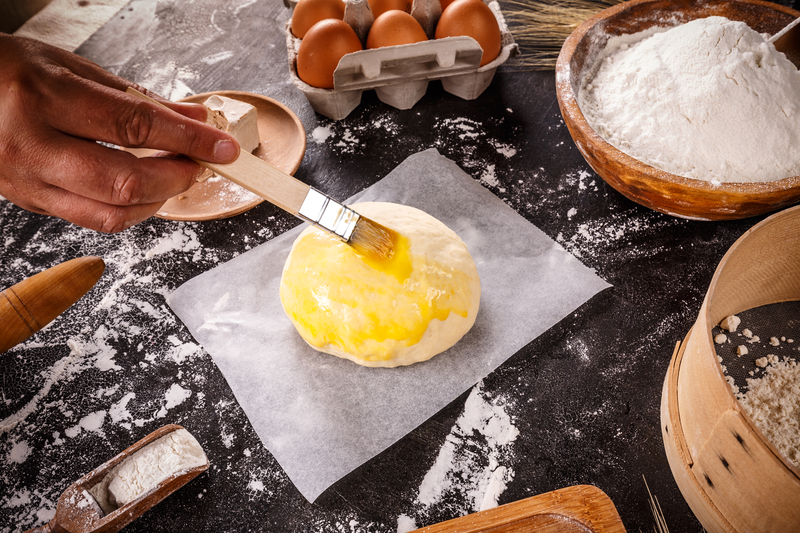 Baking bread is a time-honored culinary tradition that brings the comfort of homemade goodness to our tables.
Baking bread is a time-honored culinary tradition that brings the comfort of homemade goodness to our tables.
The process of creating the perfect loaf involves a delicate balance of ingredients and techniques.
One technique that has gained popularity among bakers is brushing bread with butter before baking.
This seemingly simple step can have a profound impact on the final outcome of your bread, influencing its flavor, texture, and appearance.
In this article, we delve into the reasons behind butter-brushing and explore whether it’s a practice worth adopting.
1. The Golden Crust Factor: Aesthetic Appeal
The practice of brushing bread with butter before baking is often employed to achieve a beautifully golden and glossy crust.
The butter creates a thin, rich layer on the surface of the dough that caramelizes during baking.
This results in a lustrous, golden-brown crust that’s not only visually appealing but also hints at the delectable flavor within.
The contrast between the crust and the soft interior can be particularly enticing, making the bread even more irresistible to the eyes and taste buds.
2. Flavor Infusion: Butter’s Subtle Contribution
While the primary purpose of brushing bread with butter is to enhance its appearance, the technique can also subtly influence its flavor.
Butter carries its own distinct taste, with a touch of richness and warmth that can complement the natural flavors of the bread.
However, it’s worth noting that the flavor contribution of butter is relatively modest, and it might not significantly alter the overall taste of the bread.
Therefore, this step is more about subtle enhancement than radical transformation.
3. Texture Enrichment: Crispness and Softness in Harmony
Texture is a crucial element in bread baking, and the application of butter can play a role here as well.
As the butter melts and interacts with the dough’s surface, it creates a micro-thin layer that can contribute to a delicate, slightly crisp texture in the crust.
Simultaneously, the steam generated during baking can interact with the butter to maintain a softer crumb inside.
This interplay of textures can lead to a more satisfying eating experience, where the crust provides a gentle crunch before yielding to the tender interior.
4. Considerations and Variations
While butter-brushing has its merits, it’s important to consider a few factors before incorporating this technique into your bread-baking routine:
a. Fat Content: Butter is high in fat, and while this can contribute to a rich flavor and texture, it’s essential to balance it with other ingredients to avoid an excessively greasy result.
b. Dietary Preferences: If you’re conscious of your dietary choices, consider using alternatives to butter, such as olive oil or egg wash, to achieve similar effects without the dairy component.
c. Baking Time and Temperature: Experimentation is key. Adjusting the baking time and temperature can help you achieve the desired level of crustiness and color, ensuring the butter-enriched surface doesn’t become overly browned.
d. The Bread Type: While butter-brushing can work well with various bread types, some loaves, like artisanal sourdough, might benefit more from this technique due to their open crumb structure.
To Butter or Not to Butter?
In the world of bread baking, there’s no one-size-fits-all answer.
The decision to brush your bread with butter before baking depends on your preferences and the results you seek.
If you’re aiming for an inviting appearance, a subtle flavor enhancement, and an interplay of textures, butter-brushing might be worth a try.
However, it’s essential to maintain a balance and exercise experimentation, taking into account the specific bread recipe you’re working with.
Is it Better to Bread Brush with Butter Before or After Baking?
 The choice of whether to brush bread with butter before or after baking presents a dynamic culinary decision.
The choice of whether to brush bread with butter before or after baking presents a dynamic culinary decision.
Buttering before baking introduces a fusion of flavors as the butter melds with the dough during the baking process, yielding a harmonious taste profile, while also enhancing the crust’s appearance with a glossy golden finish.
This approach can also create an engaging texture interplay between the slightly crisp crust and the tender interior.
Conversely, buttering after baking preserves the bread’s freshness, offers a more personalized control over buttery flavor distribution, and provides an avenue for creative toppings.
The decision rests on individual preferences, bread type, and desired outcomes, encouraging experimentation to find the perfect balance of flavor, texture, and aesthetics in one’s homemade bread.
Bottom Line – Should I Brush Bread with Butter Before Baking?
In the realm of bread baking, the choice of when to apply butter is as much about personal preference as it is about the desired outcome.
Butter before baking brings forward integrated flavors, golden aesthetics, and a delicate texture interplay.
Butter after baking offers customization, freshness retention, and a canvas for creative toppings.
Ultimately, the decision should be guided by the specific bread type, your taste aspirations, and your willingness to explore the delightful realm of butter’s influence on your homemade loaves.
Whichever method you choose, the heartwarming aroma and satisfaction of baking your own bread will always be a cherished reward.


